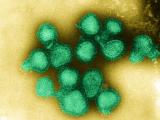Aug 23, 2011 (CIDRAP News) – An Australian study that compared levels of adverse reactions in adults who received two different flu vaccines in 2010 has found a higher level of injection site reactions in those who received Fluvax, the CSL Biotherapies vaccine that was linked to febrile seizures in young children.
The report, published yesterday in an early online edition of Vaccine, also contains new details about the how the vaccine is made, with the authors speculating that reactions might stem from possible problems related to a chemical process CSL uses to inactivate and split the flu vaccine viruses.
CSL, based in Australia, withdrew its seasonal flu vaccine in June 2010 after hundreds of children under age 5 experienced febrile seizures after they were immunized. In September 2010 the country's drug regulators confirmed the link between the increased rate of seizures and the vaccine, but so far a cause of the reactions has not been found.
Earlier this summer the US Food and Drug Administration (FDA) released a warning letter that it sent to CSL, citing deviations from good manufacturing practices that it found at the firm's Parkville, Victoria, plant.
On Aug 17 CSL said it is still working on resolving the issues the FDA identified in its warning letter. The company's managing director, Brian McNamee, told the Australian Associated Press that the CSL's investigation determined that the reactions were caused by a "surprise interaction" between the flu strains that were in the 2010 vaccine and that scientists haven't determine what caused the reaction between the strains.
The company's vaccine was available as Afluria in the United States last flu season, but not in the 0.25-mL prefilled syringe doses used in very young children. The vaccine shipped with a labeling change notifying healthcare providers about the increased incidence of fever and febrile seizures during the Southern Hemisphere's 2010 flu season.
To assess for any unusual patterns in adults, researchers in the current study interviewed 350 adults who were vaccinated in a large clinic in Western Australia state from Mar 11, 2010, through Apr 24, 2010. Though the vaccine brand wasn't recorded in the patient data, researchers were able to determine which brands they received—either the CSL or Solvay trivalent inactivated vaccine (TIV)—from distribution records.
They found higher rates of muscle pain and swelling after vaccination in the Fluvax group, though the rates for both vaccines were within the levels listed in the product inserts. "Our finding that Fluvax vaccine appears to be more locally reactogenic in adults suggests that the immunologic determinants of the increased rate of adverse reactions observed in 2010 may not be limited to children," the group wrote.
Investigators noted that CSL's vaccine is made with a unique process that uses beta-propiolactone and sodium taurodeoxycholate to inactivate and split the flu virus, and they wondered if the issues the FDA raised about the company's failure to determine optimal splitting conditions and failure to establish a procedure to ensure the completeness of virus splitting could explain the unusual patterns seen with Fluvax.
They added that the profile of adverse reactions to the CSL vaccine in children and adults resembles that seen for whole-virus flu vaccines.
Limitations of the study include that subjects may have had difficulty remembering details about adverse effects and flu vaccination when the survey took place about 7 month later, the researchers said. Also, they noted that some of the participants could have been aware of the vaccine's link to febrile seizures in young children.
However, they noted that passive surveillance of adverse flu vaccine reactions in adults in Western Australia during a similar period found a threefold higher rate for the CSL vaccine than for the Solvay vaccine.
They concluded that more work is needed to determine if there is a link between the vaccine's adverse effects in children and those in adults.
Leeb A, Carcione D, Richmond PC. Reactogenicity of two 2010 trivalent inactivated influenza vaccine formulations in adults. Vaccine 2011 (published online Aug 22) [Abstract]
See also:
Jun 22 CIDRAP news scan
Aug 17 CIDRAP news scan



















